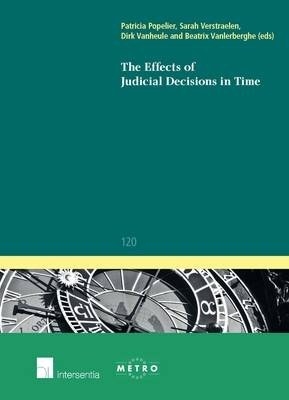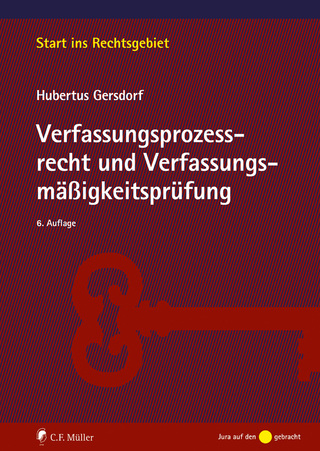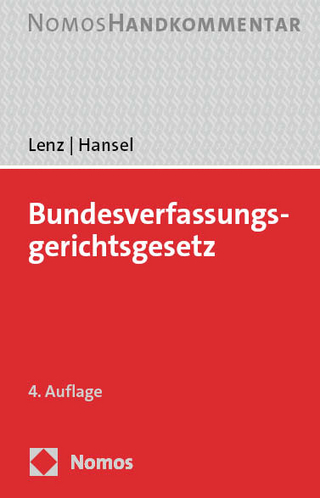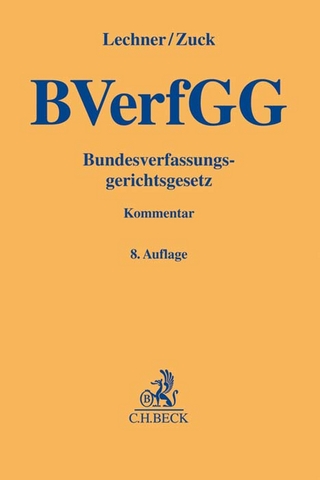
The Effects of Judicial Decisions in Time
Intersentia Ltd (Verlag)
978-1-78068-188-7 (ISBN)
- Titel ist leider vergriffen;
keine Neuauflage - Artikel merken
Chapter 1. The Effect of Judicial Decisions in Time: Comparative Notes Patricia Popelier, Sarah Verstraelen, Dirk Vanheule and Beatrix Vanlerberghe 1. Introduction 2. A comparative overview: threads 2.1. The need for flexibility 2.2. The Court's discretion 2.3. Variations in approaches to the balancing exercise 3. Definition and terminology 3.1. Effect ex tunc 3.2. Effect ex nunc 3.3. Effect pro futuro 3.4. Umbrella terms 4. Approach in this volume PART I CONSTITUTIONAL COURTS: EFFECTS EX TUNC Chapter 2. Germany Bundesverfassungsgericht - Excerpt from the Judgment of the First Senate of 28 March 2006 on the basis of the oral hearing of 8 November - 1 BvR 1054/01 - Temporal Effects of Decisions of the German Federal Constitutional Court Werner Schroeder 1. Introduction 1.1. Decision of the Federal Constitutional Court in the Sports Betting case 1.2. Role of the FCC within the German judicial system 2. Limitation of the legal effects of judgments through a declaration of incompatibility 2.1. Development of the practice 2.2. Legal basis of the practice 2.3. Prerequisites of a declaration of incompatibility 2.3.1. Declaration of incompatibility to preserve the scope of manoeuvering of the legislature 2.3.2. Declaration of incompatibility to prevent a situation 'more remote from the Constitution' 3. Legal effects of the declaration of incompatibility 3.1. Ban on application as standard consequence of the declaration of incompatibility 3.2. Continued application despite declaration of incompatibility due to order by the FCC 3.3. Provisional orders of the FCC 4. Resume Chapter 3. Belgium Belgian Court of Cassation - 20 December 2007 - C.07.0227.N The Interplay of Temporal Effects of Judicial Decisions within the Belgian Legal Order Sarah Verstraelen 1. Introduction 2. Belgian Constitutional Court 2.1. Appeals for annulment 2.1.1. General temporal effect 2.1.2. Deviation from the general temporal effect 2.1.2.1. Legal basis 2.1.2.2. Usage 2.1.2.3. Case in point 2.2. Preliminary rulings 2.2.1. General temporal effect 2.2.2. Deviation from the general temporal effect 2.2.2.1. No legal basis 2.2.2.2. Case no. 125/2011 3. Belgian Court of Cassation 3.1. General temporal effect 3.2. Deviation from general temporal effect 3.2.1. International private law case 3.2.2. Aftermath of the ECHR Marckx case 4. Decision of the Supreme Court of 20 December 2007: interplay 4.1. Circumstances of the case 4.2. Decision of the Court of Cassation 4.3. Analysis 4.3.1. Legislative lacuna until 2008 4.3.2. Further case law 4.3.3. Competence of the Court of Cassation 4.3.4. Article 4, x2 of the Special Act on the Constitutional Court 4.3.5. Legal certainty 5. Conclusion PART II CONSTITUTIONAL COURTS: EFFECTS EX NUNC Chapter 4. Austria Decision of the Austrian Constitutional Court, December 10, 1986, VfSlg 11190/1986 Pro Futuro and Retroactive Effects of Rescissory Judgments in Austria Manfred Stelzer 1. Introduction 2. The pro futuro effect of a rescissory judgment 3. Setting deadlines 4. 'Retroactive' effect 4.1. Case in point 4.2. Granting (general) retroactive effect 5. Conclusion Chapter 5. Hungary 33/2012. (VII. 17.) AB hatarozat / Decision 33/2012 (VII. 17.) AB of the Constitutional Court of Hungary Temporal Effects of Decisions of the Hungarian Constitutional Court Timea Drinoczi 1. Introduction to the constitutional review system in Hungary 2. Temporal effects of the decisions of the Constitutional Court 2.1. Temporal effect: general rules 2.2. Invalidity (null and void) and temporal effect 2.3. The concept of 'living law' and temporal effect 2.4. Temporal effects 2.4.1. Ex nunc effect: the main rule 2.4.2. Ex tunc and pro futuro effects: deviations from the main rule 3. Decision on the constitutionality of ex nunc effect 4. Application of pro futuro effect 4.1. Suspending the setting of the date of annulment 4.2. 'Condition-setting' and combined 'condition-setting' and 'time-setting' Contents 4.3. Exact date setting 4.4. 'Warning to exercise the competence to annul' 5. Application of ex tunc effect 5.1. Decision on the general retirement case and implications 5.1.1. The decision 5.1.2. Temporal effect applied and some criticism 5.1.3. Related decision of the Court of Justice of the European Union focusing on the temporal effect of the decision of the Constitutional Court 5.1.4. Related decision of the Constitutional Court: retroactive annulment of the Transitory Provisions 5.2. Combined 'time-setting' and 'condition-setting' 6. Conclusion Chapter 6. France Constitutional Council of France - Decision no. 2010-108 of 25 March 2011 Temporal Effects of Judicial Decisions in France Francois-Xavier Millet 1. The Constitutional Council's broad approach to the immediate effects of abrogation 1.1. A limited retroactive effect 1.2. The adoption of transitory measures by the constitutional judge 2. The grounds for a deferred abrogation 2.1. The respect for parliamentary will 2.2. The 'patently disproportionate consequences' test 2.3. The immediate application of EU law 2.4. The emphasis on the 'usefulness' of the QPC decision 3. Conclusion Chapter 7. Italy Italian Constitutional Court - Judgment no. 113 of 2011 The Temporal Effects of the Italian Constitutional Court and the Mechanism of Warning Decisions Giuseppe Martinico 1. Introduction and overview of the relevant literature 2. The Dorigo saga as a case study 2.1. Factual background 2.2. Dorigo I Contents 2.3. Dorigo II: the relevance of the ECHR in the case law of the ICC 2.4. Why Dorigo II is relevant 3. Final remarks PART III SUPR EME COURTS Chapter 8. The UK Opinions of the Lords of Appeal for Judgment in the Cause National Westminster Bank plc v. Spectrum Plus Ltd and others [2005] UKHL 41 on 30 June 2005 The Temporal Effect of Judgments in the United Kingdom Ben Juratowitch 1. Introduction 2. Adjudicative retroactivity 2.1. Private law: Kleinwort Benson v. Lincoln City Council 2.2. Public law: R v. Governor of Brockhill Prison, ex p Evans (No. 2) 2.3. Criminal law: Shaw v. DPP 3. Consideration of prospective overruling in the United Kingdom 4. Problems with prospective overruling 4.1. Where the new rule does not apply to the case in which it is announced 4.2. Where the new rule does apply to the case in which it is announced 4.3. Where the new rule concerns the interpretation of a statute 4.4. Evaluation of prospective overruling 5. Conclusion Chapter 9. The Netherlands High Council 13 November 1991, No. 27563, BNB 1992/109 The Temporal Effect of Dutch Tax Court Decisions Hans Gribnau and Allard Lubbers 1. Introduction 2. The temporal effect of court decisions in tax cases 2.1. The duties of the tax courts 2.2. Interpreting tax legislation 2.3. Tax courts as developers of the law 2.4. Principles of proper administration 2.5. Review of tax regulations 3. Instruments to limit the temporal effect 4. Grounds for limiting the temporal effect 5. Conclusion Contents Chapter 10. Israel Summary of the Judgment in HCJ 6298/07 Ressler, adv. (IDF Major, ret.) v. The Knesset Time and Judicial Review in Israel: Tempering the Temporal Effects of Judicial Review Ittai Bar-Siman-Tov 1. Introduction 2. General rule about the temporal effects of judicial decisions 3. Tempering the temporal effects of judicial decisions invalidating statutes 3.1. Doctrine of relative voidance 3.1.1. Absolute voidance, voidablity and relative voidance 3.1.2. Relationship between relative voidance and prospective effect 3.2. Suspension of the declaration of invalidity 3.2.1. Relationship between suspension and prospective effect 3.2.2. Relationship between suspension and relative voidance 4. From theory to practice: the actual use of modulating remedies 4.1. Application of Solel Boneh in later cases 4.2. Expansion and prevalence of relative voidance in Israeli law 4.3. Remedies employed in cases invalidating statutes 4.3.1. Trend towards modulated invalidations 4.3.2. The surprising absence of relative voidance 4.3.3. Emergence of suspension as the preferred remedy 4.3.4. Prospective application as the latest development 5. Normative evaluation 5.1. Modulated remedies and rights 5.2. Modulated remedies and separation of powers 5.3. The need for flexibility and the fear of unbridled discretion 5.4. The appropriate approach 6. Conclusion PART IV EUROPEAN COURTS Chapter 11. The Court of Justice of the European Union Court of Justice of the European Union, C-292/04, Meilicke and others v. Finanzamt Bonn-Innenstadt, 6 March 2007 [2007] ECR I-1835 Limitation of Temporal Effects of CJEU Judgments: Mission Impossible for Governments of EU Member States Michael Lang 1. Meilicke and the CJEU case law on the limitation of the temporal effects of the CJEU 2. Existing case law on the limitation of temporal effects of CJEU judgments 2.1. The rule and the exception 2.2. Good faith and legal uncertainty 2.3. Serious economic repercussions 3. Limitation of temporal effects: applicable in all Member States? 3.1. The relevant judgment 3.2. Good faith and legal uncertainty 3.3. Serious economic repercussions 4. Conclusion Chapter 12. The European Court of Human Rights ECtHR, Legrand v. France (App No 23228/08) 26 May 2011 The European Court of Human Rights' Approach to Retrospective Judicial Reversals Patricia Popelier 1. Legrand: a failed operation and the quest for damages 2. Retroactive reversals and the principle of legal certainty 2.1. Reversals in the case law of the ECtHR 2.2. Reversals in the case law of national courts 3. The legitimacy of reversals in the case law 3.1. The legitimacy of reversals in the case law of the ECtHR 3.2. The legitimacy of reversals in the case law of national courts 4. The retroactive application of reversals 4.1. The temporal effect of ECtHR judgments 4.2. The temporal effect of national judicial judgments 5. Conclusion
| Erscheint lt. Verlag | 17.10.2013 |
|---|---|
| Reihe/Serie | Ius Commune Europaeum ; 120 |
| Verlagsort | Cambridge |
| Sprache | englisch |
| Maße | 172 x 236 mm |
| Gewicht | 515 g |
| Themenwelt | Recht / Steuern ► EU / Internationales Recht |
| Recht / Steuern ► Öffentliches Recht ► Verfassungsverfahrensrecht | |
| ISBN-10 | 1-78068-188-7 / 1780681887 |
| ISBN-13 | 978-1-78068-188-7 / 9781780681887 |
| Zustand | Neuware |
| Haben Sie eine Frage zum Produkt? |
aus dem Bereich


